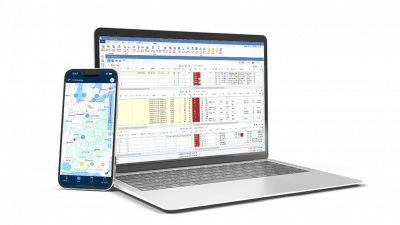Transportation dispatching is vital for managing fleet movement and cargo transportation. With trucks moving about 72.6% of the nation’s freight, efficient dispatching is crucial for trucking’s economic and operational success.
This article explores transportation dispatch software, a vital tool in optimizing carrier fleet management and operational efficiency. We’ll examine its functionalities, benefits, and challenges so you can make an informed decision on whether it suits your needs.
What Is Transportation Dispatch Software?
Transportation dispatch software is a comprehensive tool for managing carrier fleets, tracking drivers, and efficiently handling backend logistics. This centralized platform simplifies transportation logistics and improves carrier dispatch efficiency.
The main advantage of transportation dispatch tools is that they facilitate smooth operations. The software automates critical processes like routing and scheduling, aiding business owners in informed decision-making to improve delivery performance and service speed.
Dispatching tools are available as standalone programs or as part of all-in-one transportation management software (TMS). Integrating various aspects of transportation management into a TMS simplifies managing loads and coordinates logistics.
Transportation businesses that want to optimize their operations need trucking dispatch software, whether standalone or integrated. It’s not just about managing loads; the software includes task scheduling and assignment functionalities, personnel and equipment tracking, and customer interaction management. These features transform it into a strategic efficiency and cost-saving tool.
How Does Trucking Dispatch Software Work?
Trucking dispatch software transforms dispatching and truck fleet management by automating or streamlining critical dispatch tasks. This technology plays a pivotal role in enhancing the efficiency of fleet operations, with primary functions that include:
- Real-time Driver Availability: Identifying drivers that are currently available.
- Load Assignment: Efficiently allocating loads to drivers.
- Route Optimization: Planning the best routes to save time and fuel.
- Fleet and Load Tracking: Optimizing fuel usage costs.
- Driver Logs: Maintaining detailed driver activity records.
- Fleet Analytic Reports: Providing data-driven insights into fleet operations.
Challenges in Trucking Dispatch
Trucking dispatch is a complex and dynamic field that faces numerous challenges. Despite advancements in transportation dispatch software, fleet managers and dispatchers navigate logistical complexities and external factors that disrupt well-planned schedules daily. Understanding these challenges is key to successful fleet management.
Optimizing Route Efficiency
Optimizing route efficiency is a critical yet challenging aspect of trucking dispatching that involves multiple variables to generate efficient delivery routes. Truck route planning faces many challenges, including unpredictable weather and road closures. Manual routing processes make it harder to adapt, which can cause delays.
Companies should utilize modern trucking dispatch software with advanced AI and ML algorithms to tackle these challenges. These dynamic routing capabilities enable real-time adjustment to changing conditions to ensure safe and optimal routes, which is crucial for managing multiple location deliveries or high-volume orders.
Effective Stakeholder Communication
Effective communication among managers, dispatchers, drivers, commercial carriers, and third-party logistics (3PL) partners is vital for success. The lack of synchronized communication in critical areas such as order allotment, delivery tracking, and real-time updates often reduces transparency and efficiency. This disconnection can have a ripple effect, adversely impacting the entire delivery process.
Dispatch software can offer a solution by integrating carrier TMS with your technology stack, ensuring alignment and shared understanding over delivery KPIs (Key Performance Indicators). This integration enhances efficiency, transparency, and a streamlined delivery process, ultimately contributing to operational success.
Meeting Customer Delivery Expectations
Meeting customer delivery expectations has become a significant challenge for transportation and logistics companies. According to market research, consumers are less likely to order again from a retailer if their order is late. This challenge is compounded by the increasing consumer demand for instant and same-day deliveries, significantly narrowing delivery windows.
Intuitive trucking dispatch systems, analyzing real-time data, and automating task allocation play a crucial role. Automation enhances productivity, allowing dispatchers to plan multi-stop routes and ensure prompt deliveries.
Enhancing Customer Engagement
As supply chains become more complex, customers demand more than just product delivery; they demand exceptional service quality and faster delivery times. Enhancing customer engagement through real-time tracking and updates during shipment and delivery is essential to building trust and confidence.
Customers also seek flexibility in delivery options like expedited services. Trucking and logistics companies must adapt and innovate to meet these needs, creating a customer experience that is informative, flexible, and responsive. In doing so, companies can build stronger relationships with their clients, ensuring their position as preferred logistics partners in a competitive market.
Implementing Automation
Traditional trucking dispatch largely relies on manual work, including whiteboard planning, logistics personnel, and phone communication between dispatchers and drivers. Managing operations manually consumes considerable time and resources and can be inefficient and error-prone.
Using transportation dispatch software, companies can automate many aspects of their dispatching processes. Automating labor-intensive tasks like freight matching and carrier accounting reduces manual labor and human error risks. Automation also allows companies to devote more time to customer service and strategic planning.
How Trucking Dispatch Software Can Help
In addition to helping companies address dispatching challenges, trucking dispatch software offers many advantages that streamline logistics operations and enhance service quality. The following are some of the benefits of trucking dispatch software:
- Efficient Route Planning and Optimization: Dispatch software automates and optimizes route planning to maximize efficiency. This reduces travel time and fuel consumption, leading to cost savings and increased productivity.
- Real-time Tracking and Visibility: One of the key benefits is the ability to track fleet vehicles in real-time. This visibility improves operational control, helps in timely decision-making, and enhances customer service by providing accurate delivery updates.
- Improved Communication and Coordination: Enhanced communication tools within the software facilitate better coordination between dispatchers, drivers, and customers. This leads to a more synchronized operation, reducing misunderstandings and delays.
- Automated Scheduling and Dispatch: Automating scheduling and dispatch processes minimizes manual errors, saves time, and maximizes resource utilization. This leads to a more streamlined operation and can improve overall fleet efficiency.
- Enhanced Reporting and Analytics: Dispatch software typically includes trucking reporting tools that provide insights into operational and fleet management metrics. These analytics can help identify areas for improvement, monitor driver performance, and support strategic planning.
- Cost Reduction and Budget Management: By automating various processes, reducing fuel consumption through optimized routing, and improving operational efficiency, dispatch software can significantly reduce operating costs.
- Compliance and Record Keeping: The software helps maintain compliance with industry regulations and standards. It aids in record-keeping by logging driving hours, maintenance schedules, and other essential records.
Top Features to Look for in Transportation Dispatch Software
When selecting transportation dispatch software, it’s crucial to identify the right features to meet your company’s needs. The best software should streamline your dispatch processes and adapt to the evolving demands of the transportation industry. Here’s what to look for.
The Ultimate Dispatching Guide
Take control of your dispatching operations and unlock the full potential of your logistics business with our free guide!
Automated Scheduling Tools
Transportation dispatching software needs automated scheduling features for efficient and effective scheduling. Advanced scheduling tools may include customizable, drag-and-drop schedulers and preexisting templates that simplify and expedite the scheduling process, allowing managers to focus more on strategic aspects of their operations.
Key functionalities of automated scheduling tools include:
- Custom Shifts: Enables shift optimization to reduce overtime costs.
- Shift Management: Allows drivers to accept, reject, or trade shifts, making schedules more flexible.
- Time-Off Requests: Streamlines the time-off request process to ensure driver availability.
Mobile Access
Transportation dispatch software should provide mobile access, allowing for convenience, flexibility, and synchronization of operations. This feature lets the team stay up-to-date on deliveries and make changes on the go, improving overall operational efficiency and customer service. It also allows truck drivers and logistics team members to manage schedules and time-off requests from their devices.
Dispatch personnel and drivers can communicate automatically with an app like PCS Mobile. The application provides concise information, facilitates mobile reporting, and incorporates business intelligence tools. The system includes active load viewing, fleet monitoring, and financial management for truckload, LTL, and intermodal operations.
Real-Time Tracking
Tracking in real-time is a critical feature in transportation dispatch software. A real-time truck monitoring system provides information about a truck’s location, speed, and direction. Using this data, dispatchers can optimize routes, estimate delivery times accurately, and offer up-to-date shipment information.
Real-time GPS tracking improves productivity and profitability, enhances customer satisfaction, promotes employee engagement, reduces idle time and shipping delays, and minimizes fuel costs and environmental impact. Dynamic ETAs and real-time GPS tracking also facilitate better customer communication about delivery expectations, increasing customer satisfaction and potentially leading to repeat business.
User-friendly and Intuitive
An intuitive and user-friendly interface is another essential for transportation dispatching software. Your chosen tool should be intuitive and easy to navigate, reducing the need for extensive training. This feature is critical for both dispatch managers and drivers, as it minimizes the administrative burden and allows quicker access to necessary features.
The software should enable vehicle inspections, compliance, dispatching, and messaging management in a unified platform. Additionally, cloud-based software that makes it easy to upload job documents can make the process more efficient and enhance user satisfaction.
Integration With Other Systems
Verify the transportation dispatch software you choose is compatible with the rest of your organization’s systems. Integrating other systems reduces the need to switch between digital tools and consulting paperwork. A dispatch software dashboard that provides access to dispatch data, GPS tracking, and telematics can significantly increase its value.
Many transportation management platform options offer fleet management features such as maintenance history, compliance reports, and transportation dispatching to streamline operations. Integrating software with accounting, CRM, and ERP facilitates a seamless process and avoids data re-entry.
Scalability and Customization
Choosing dispatching software that grows with your company is crucial. It should be capable of accommodating adding more drivers, vehicles, equipment, and other assets and supporting growing data volumes securely.
Customization is equally essential. Look for software that allows for tailored dashboards and search filters, enabling users to sort and search based on specific preferences like Dispatch ID, vehicle, or destination. You can optimize your workflow using these features to suit your company’s needs.
Discover the Best Transportation Dispatch Software With PCS TMS
As technology and logistics networks become more complex, transportation dispatch software becomes increasingly important for efficient fleet management. This software is essential for optimizing routes, improving communication, ensuring on-time delivery, automating and streamlining operations, and enhancing customer satisfaction.
PCS TMS, a leader in transportation dispatching software, offers comprehensive features tailored for the logistics and trucking industries, like automated scheduling, real-time tracking, and mobile access. Our tools are suitable for both small and large businesses, providing valuable integration and scalability to adapt to various operational needs.
Learn more about our TMS for Carriers or request a demo to see how our tools can optimize your dispatch process.



